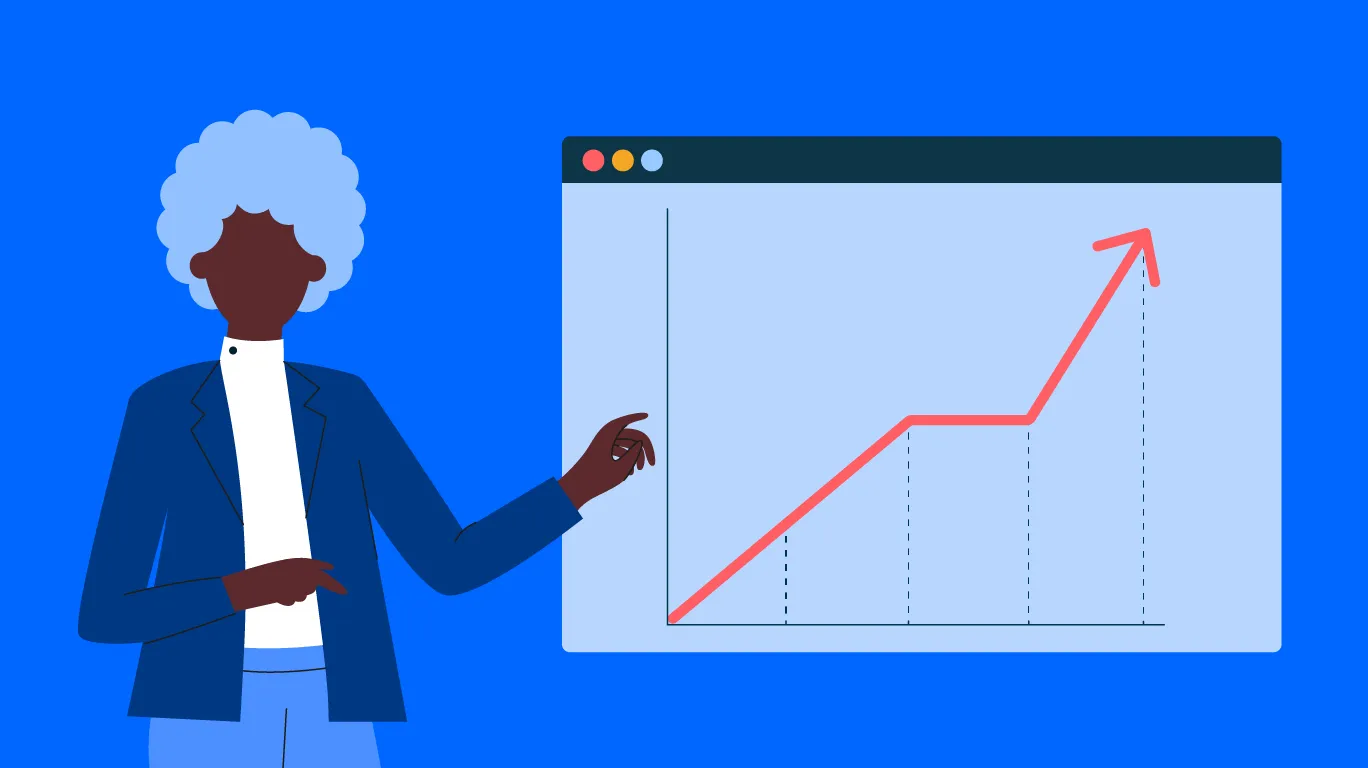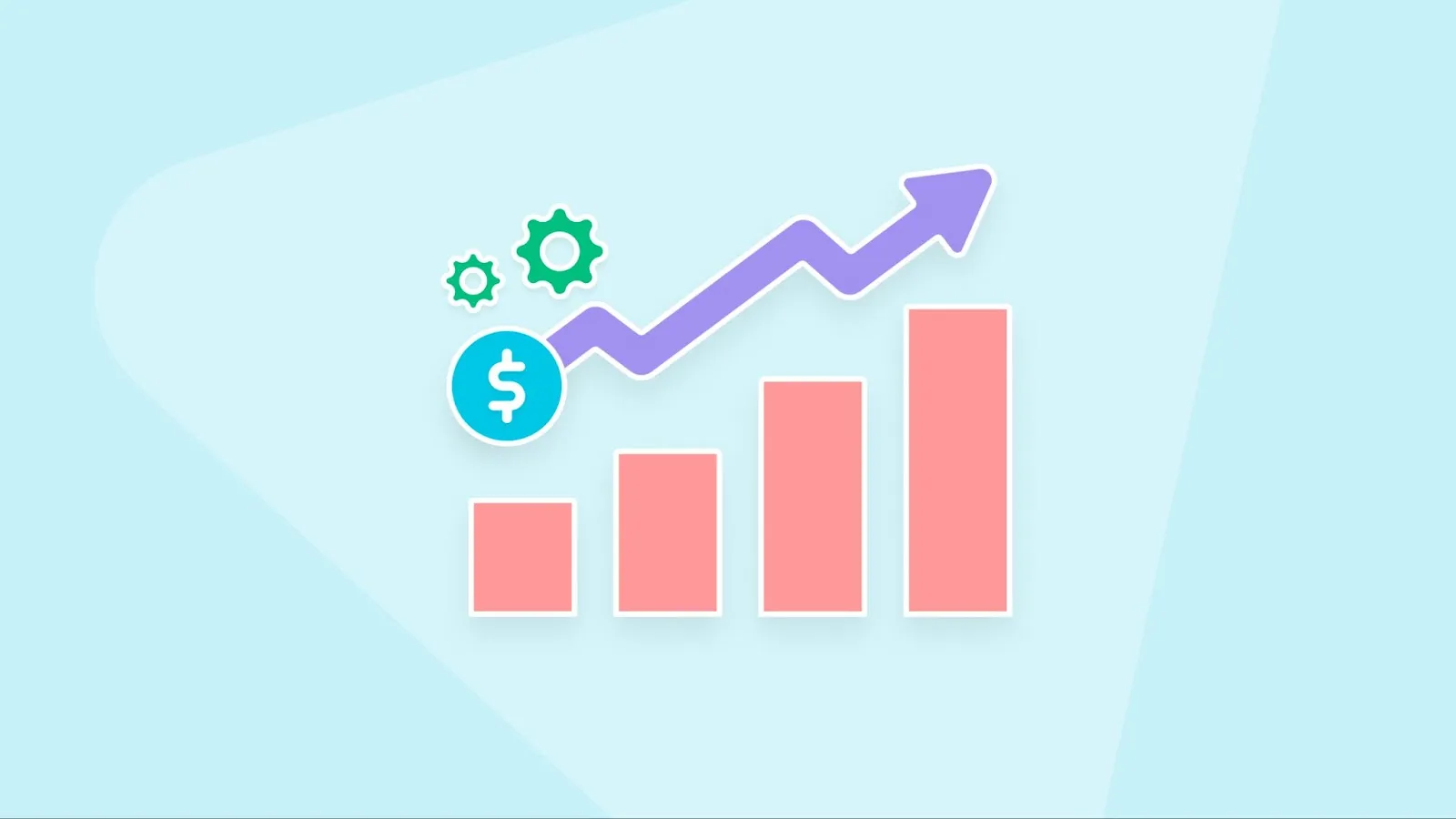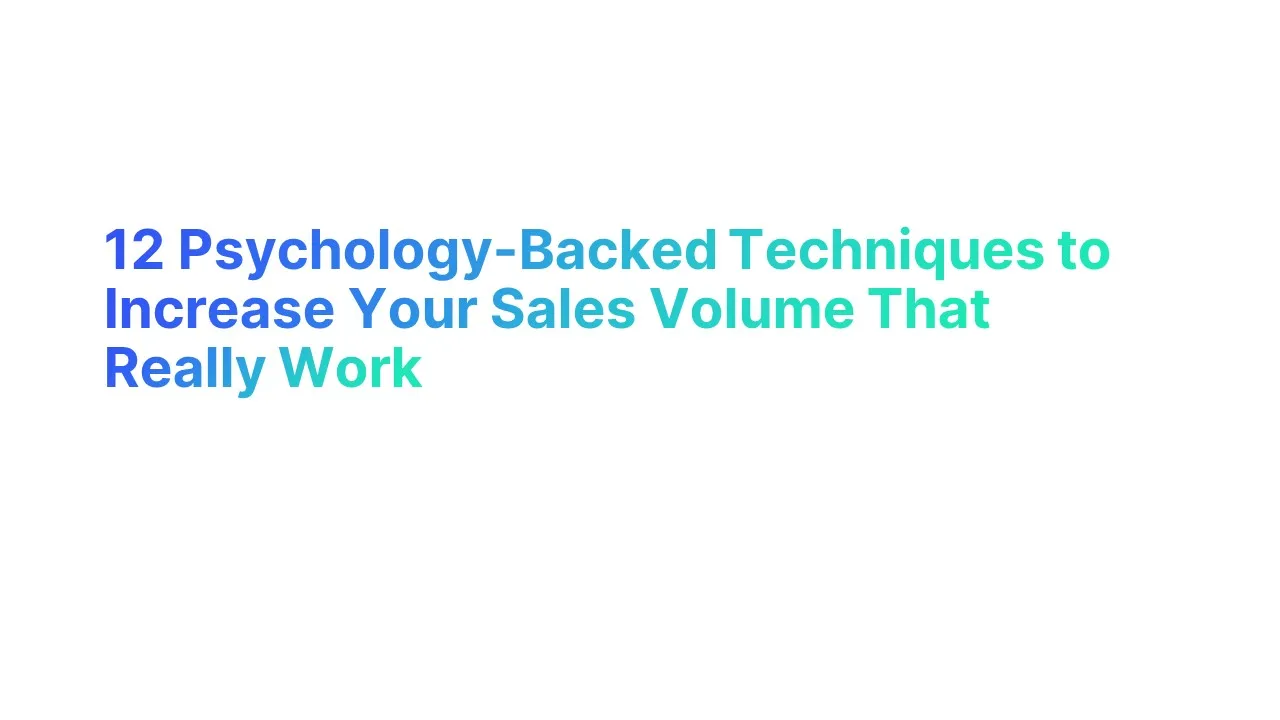Introduction to Increasing Sales Volume

Increasing sales volume refers to the strategy of increasing the number of products sold or services rendered within a specific period. This metric is crucial for businesses as it directly impacts revenue and profitability. A higher sales volume can indicate market success and business growth, making it a key performance indicator for companies across various industries.
The importance of sales volume cannot be overstated. For example, according to a Salesforce report, high-performing sales teams are 2.8 times more likely than underperforming teams to focus intensively on increasing sales volume. This focus not only increases immediate revenue but also strengthens market position and customer base, setting the foundation for sustainable growth.
Efforts to increase sales volume can involve various strategies, from enhancing product quality and customer service to optimizing marketing tactics and expanding distribution channels. By effectively increasing sales volume, businesses not only maximize their revenue potential but also improve overall business health and resilience in competitive markets.
How to Calculate Sales Volume

Sales volume, a crucial metric for assessing the performance of a business, refers to the number of units sold within a given period. Understanding how to calculate this figure is essential for businesses aiming to track growth, forecast future sales, and develop effective marketing strategies.
- Basic Calculation: The simplest way to determine sales volume is by multiplying the number of units sold by the selling price per unit. This calculation provides the total sales volume in terms of revenue.
- Detailed Tracking: To gain more insight, businesses often break down sales volume by product, region, or sales channel. For example, a company might report that it sold 50,000 units of a new product within the first month of launch, indicating a strong market reception.
Sales Volume Variance
Sales volume variance is a measure used to evaluate the difference between the expected sales volume and the actual sales achieved during a specific period. It helps businesses understand how well they are performing against their sales targets.
- Formula: The formula for calculating sales volume variance is:
Sales Volume Variance=(Actual Quantity Sold − Budgeted Quantity) × Standard Price - Interpreting Results: A positive variance indicates that the actual sales volume is higher than expected, which is generally favorable. Conversely, a negative variance suggests that the sales fell short of expectations, signaling potential issues in pricing, marketing, or market conditions.
For instance, if a company had budgeted to sell 10,000 units at $10 each but only sold 8,000 units, the sales volume variance would be:
(8,000 − 10,000) × $10 = −$20,000
This negative variance indicates that the company's sales performance was below expectations, leading to $20,000 less in revenue than planned.
Understanding and analyzing sales volume and its variance can provide critical insights into market dynamics and operational effectiveness, guiding strategic decisions and adjustments to achieve better alignment with market demands.
Sales Volume vs Sales Revenue
12 Psychological Ways to Increase Your Sales Volume

Here’s a list of 12 psychology-backed techniques to increase your sales volume, designed to tap into customer behaviors and decision-making processes:
1. Leverage Social Proof
Social proof is a powerful psychological trigger that influences potential customers by showing that others have made purchases and are satisfied with their decision. It effectively reassures buyers about the quality and popularity of your product.
- Customer Reviews and Testimonials: Displaying customer reviews prominently on your product pages can significantly boost trust. For instance, a study from the Spiegel Research Center found that displaying reviews can increase conversion rates by up to 270%.
- User-Generated Content: Share photos, videos, and stories from users on social media and your website. Seeing real people endorse your product can drive others to make a purchase.
- Usage Statistics: Sharing data like "Over 10,000 units sold!" or "Join 20,000 satisfied customers!" can enhance the perceived popularity and reliability of your product.
Increasing Sales Volume: Implement a system to collect and display reviews on your website. Encourage satisfied customers to share their experiences online. Include a review section on product pages and make it easy for customers to contribute their feedback.
2. Highlight Exclusive Benefits
Pointing out the exclusive benefits of your product makes it stand out from the competition. This strategy taps into the customer's desire to obtain unique solutions that others might not offer.
- Unique Selling Proposition (USP): Clearly articulate what makes your product different and better than others. Is it more durable, more effective, or perhaps more eco-friendly?
- Limited Editions and Exclusive Offers: Offering products that are available only for a limited time or in limited quantities can make them more desirable.
- Product Bundling: Combine products in a unique way that offers more value and convenience than purchasing them separately.
Increasing Sales Volume: Emphasize these exclusive benefits in all your marketing and sales copy. Use them as key points in your advertising campaigns, ensuring they are front and center on landing pages and during promotions.
3. Create a Sense of Urgency
Creating a sense of urgency encourages customers to make a purchase decision quickly, usually by suggesting that they might miss out if they delay.
- Time-Limited Offers: Promote sales that last for a limited time. Phrases like "Offer ends soon!" or "Only 2 days left!" prompt quick action.
- Stock Availability Alerts: Inform customers when stock levels are low ("Only 5 items left in stock!") to nudge them toward making a purchase before it's too late.
- Flash Sales: Organize sudden, short-term discounts to spur immediate purchases.
Increasing Sales Volume: Use countdown timers on your website for deals that are about to expire. Regularly update your stock levels to reflect urgency on product pages. Ensure that all marketing materials communicate the time-sensitive nature of your offers.
4. Employ the Decoy Effect in Pricing
The Decoy Effect is a cognitive bias where consumers tend to change their preference between two options when presented with a third option that is asymmetrically dominated. This method can be particularly effective in guiding customers to choose the more expensive of two options.
- Setting up the Decoy: Introduce a third pricing option that is less attractive than the one you want to sell most, but priced similarly. This makes the desired option appear more valuable.
- Example of the Decoy Effect: If you offer a basic product at $10, a premium product at $20, and then introduce a slightly less attractive option than the premium for $18, more customers will likely choose the $20 option over the $10 option.
- Comparison Ease: Make comparisons easy on pricing pages by highlighting the benefits of the premium option next to the decoy.
Increasing Sales Volume: Strategically place the decoy option in your pricing structure to nudge customers towards higher-priced items, effectively increasing your average sale per customer. Ensure that marketing materials clearly differentiate the value between the options to highlight the attractiveness of the preferred choice.
5. Optimize for Convenience
Making the purchasing process as convenient as possible reduces friction, making it more likely that a customer will complete a purchase. This involves streamlining every step from product search to checkout.
- Simplify Navigation: Ensure that your website or store is easy to navigate, allowing customers to find what they need quickly.
- Speed Up the Checkout Process: Reduce the number of steps needed to complete a purchase. For online stores, this could mean allowing guest checkouts without needing an account.
- Mobile Optimization: With a significant amount of shopping done on mobile devices, ensure your website is optimized for mobile. A responsive design and fast loading times are crucial.
Increasing Sales Volume: Conduct user testing to find and eliminate pain points in your buying process. Implement features like saved payment information to speed up future transactions and retain customers.
6. Utilize Reciprocity
Reciprocity is a social norm that suggests people feel obliged to give something back when something is received. This can be leveraged in sales by providing customers with small gifts or bonuses.
- Free Samples or Trials: Offering free trials or samples of your product invites customers to try without risk, and they might feel compelled to make a purchase as a form of gratitude.
- Bonus Gifts with Purchase: Include a free gift with purchases over a certain amount. This not only enhances perceived value but also increases customer satisfaction and loyalty.
- Helpful Content: Provide valuable information or tutorials related to your products for free. Customers will appreciate the useful content and may feel more inclined to support your business.
Increasing Sales Volume: Integrate freebies or useful bonuses into the sales process. For instance, a skincare company could include a free applicator with a purchase of their cream. This not only enhances the product experience but also encourages repeat purchases.
7. Anchor Your Prices
Price anchoring plays on the first price seen by consumers, which they use as a reference point for subsequent purchasing decisions. This technique can significantly influence customer perception of price value.
- Introduction of a High Anchor: Start by presenting a higher-priced option before showing more economically priced items. This makes the lower prices seem even more attractive in comparison.
- Bundled Offers: Present bundled products at a seemingly reduced rate compared to buying items individually, setting the standalone prices as the anchor.
- Strategic Display: Place the most expensive items at the forefront of catalogs or webpages to establish a high price anchor.
Increasing Sales Volume: Use the anchor price as a marketing tool to make other options look more appealing. This can lead to increased sales of the mid-tier products, which are often the most profitable.
8. Harness the Power of FOMO (Fear of Missing Out)
FOMO can drive consumers to make purchases based on the anxiety of missing out on a beneficial experience that others are having. This is particularly effective with limited-time offers or exclusive products.
- Limited-Time Offers: Communicate time-sensitive discounts or availability, such as "only available for the next 24 hours" to encourage immediate purchases.
- Social Proof: Show real-time data or testimonials of others buying or enjoying the product, enhancing the feeling that one might miss out.
- Exclusivity: Offer special editions or members-only products to make customers feel they are part of an exclusive group.
Increasing Sales Volume: Implement countdown timers on offers and highlight how many people have already purchased the product. Use social media to showcase customers enjoying your product, further amplifying FOMO.
9. Emphasize Product Fit to Solve Pain Points
Identifying and addressing specific customer pain points can make your product indispensable. Tailoring your messaging to speak directly to these needs enhances the perceived value of your solution.
- Customer Feedback: Use surveys and feedback tools to discover and understand the challenges your customers face.
- Tailored Solutions: Highlight how your product specifically addresses these pain points. For example, if you sell ergonomic chairs, emphasize how they prevent back pain, a common issue for desk workers.
- Case Studies: Provide examples of how your product has solved problems for other customers, reinforcing its effectiveness.
Increasing Sales Volume: Customize your marketing materials to focus on solutions to common pain points. This targeted approach can convert more leads by directly addressing customer needs.
10. Implement Reward Systems
Reward systems encourage loyalty and repeat purchases by offering incentives that are valuable to the customer. This method can enhance the customer relationship and increase sales over time.
- Loyalty Points: Offer points for every purchase, which can be redeemed for discounts, products, or special privileges.
- Referral Bonuses: Encourage customers to refer friends by offering them a reward for each successful referral.
- Tiered Rewards: Create a membership program with tiers that offer increasing rewards as customers move up the levels.
Increasing Sales Volume: Design a rewards program that is easy to understand and genuinely valuable to the customer. Promote it actively to your customer base and ensure it is seamlessly integrated into the purchasing process.
11. Enhance Mobile Experience
Optimizing the mobile experience is crucial as an increasing number of consumers use smartphones and tablets to shop online. A seamless mobile experience can significantly enhance customer satisfaction and increase sales volume.
- Responsive Design: Ensure your website is fully responsive, meaning it adjusts smoothly to different screen sizes and orientations. This avoids layout issues and enhances usability on mobile devices.
- Fast Loading Times: Mobile users expect quick loading times. Reducing image sizes, leveraging browser caching, and minimizing redirects can help speed up your mobile site.
- Easy Navigation and Checkout: Simplify navigation and streamline the checkout process on mobile. Consider features like a fixed navigation bar, autofill information, and digital wallets to expedite transactions.
Increasing Sales Volume: Regularly test and update your mobile site to ensure it provides a fast, easy, and enjoyable shopping experience. Use mobile-specific analytics to track user behavior and identify areas for improvement.
12. Focus on Emotional Engagement
Emotional engagement involves connecting with your customers on a deeper, more personal level. This can foster loyalty and increase sales as customers feel a stronger attachment to your brand.
- Storytelling: Incorporate storytelling into your brand communications to convey the passion and purpose behind your business. Stories about your brand’s origins, challenges overcome, or customer transformations can resonate deeply with audiences.
- Visuals and Media: Use compelling visuals, videos, and audio content to evoke emotions. These can be more effective than text alone in capturing attention and conveying messages.
- Community Involvement: Engage with your community both online and offline. Activities like hosting events, supporting local causes, or interacting through social media can build a positive emotional connection with your brand.
Increasing Sales Volume: Develop marketing campaigns that tell a story or tap into common human emotions such as happiness, nostalgia, or even fear (as appropriate). Tailor content to elicit emotional responses that align with your brand values and the interests of your target audience
Concluding Thoughts on Using Psychological Ways
In conclusion, the techniques outlined offer a strategic blueprint for businesses aiming to enhance their sales volume. Leveraging psychological principles such as social proof, urgency, and reciprocity can dramatically influence consumer behavior, leading to higher sales volumes and greater market success.
Each strategy, from employing the Decoy Effect in pricing to enhancing the mobile shopping experience, serves to align your product more closely with customer desires and expectations. As businesses continue to navigate competitive markets, these psychological insights provide a robust foundation for not just meeting but exceeding sales targets. Effective implementation of these methods will not only boost sales but also foster stronger customer relationships and loyalty, which are crucial for long-term success.





.webp)


